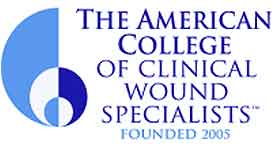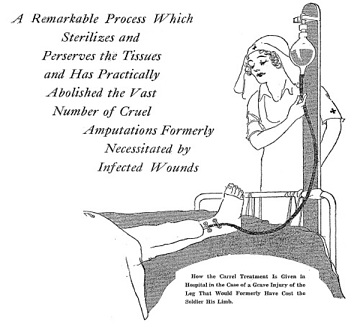During the First World War (1914-1918), antiseptics were commonly used to combat infection as championed by the Father of Modern Surgery, Dr. Joseph Lister 1 . The heavily manured soil of Western Europe was a breeding ground for deadly gas forming anaerobic infections commonly known as gas gangrene2. Soldiers who sustained injuries in the trenches feared this dreaded malady for good reason, most of the contemporary antiseptics such as carbolic acid were ineffective against Clostridium perfringens, the causative bacteria3.
To combat this infectious threat a French surgeon, Alexis Carrel, and English chemist, Henry Dakin, developed a solution of sodium hypochlorite to irrigate wounds after surgical debridement which killed most bacteria without damaging healthy tissue4. The Carrel-Dakin Method was adopted throughout Europe and resulted in many lives and limbs being saved.

About the Author
Christine Miller DPM, PhD, CWSP, FACCWS
U N I V E R S I T Y O F F L O R I D A C O L L E G E O F M E D I C I N E
Christine Miller DPM, PhD is a certified wound specialist by the American Board of Wound Management and is the Chair Elect of the Board of Directors for the American College of Clinical Wound Specialists. She currently serves as both the Co-Director of the Limb Salvage Program and Medical Director of the Orthopaedic Ambulatory Care Center Clinic at the University of Florida, College of Medicine-Jacksonville. The research aspect of wound healing is of great interest, and she participates in clinical trials.
Dr. Miller completed a Post-Doctoral Clinical Fellowship in Patient Safety and is a Coaching Fellow for the Institute for Healthcare Improvement (IHI) in the Leadership and Organizing for Change program. She formerly served as Chair of the Medicine Department at Temple University School of Podiatric Medicine and taught lower extremity radiology
References:
- Pitt, Dennis, and Jean-Michel Aubin. “Joseph Lister: Father of Modern Surgery.” Canadian Journal of Surgery, vol. 55, no. 5, Oct. 2012, pp. E8–E9., doi:10.1503/cjs.007112.
- Bourke, Joanna. “War’s Carnage: Wounds and Weapons.” The Lancet, Elsevier, 14 Apr. 2016, www.sciencedirect.com/science/article/pii/S0140673616302094?via%3Dihub
3. Hampton, Ellen. “How World War I Revolutionized Medicine.” p. 2.
4. Keyes, Michael, and Rachel Thibodeau. “Dakin Solution (Sodium Hypochlorite).” StatPearls [Internet]., U.S. National Library of Medicine, 5 Apr. 2019, www.ncbi.nlm.nih.gov/books/NBK507916/.







